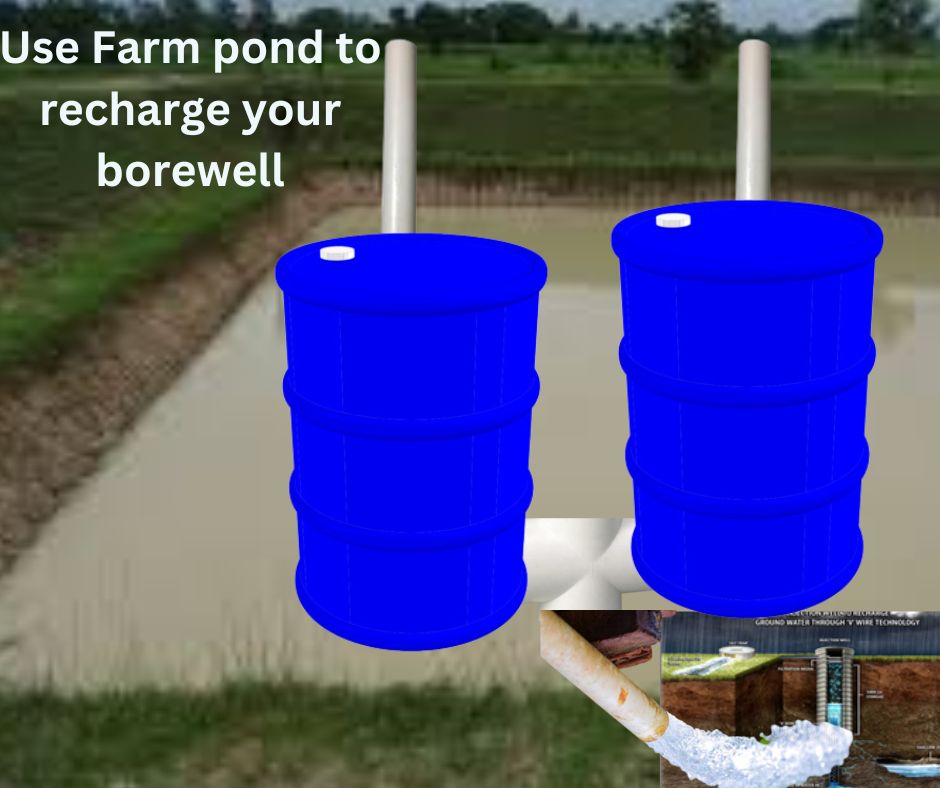Dry borewell recharge
Recharge your borewell using rainwater and stop spending thousands and lakhs of rupees for new borewell.

Dry borewells doesnot need rebore, rather it can be recharged.
Borewells are always expensive, yet residents continue to plan for new borewells to take groundwater while ignoring old ones on their property.
Borewell is like a deposit It is not a reliable water source. The earth’s surface rocks split up a number of years ago, allowing water to seep underground and be stored in both confined and unconfined aquifers.
Water-filled layers called aquifers are impermeable. Confined aquifers are single-layered and without cracks. Contrarily, non-confined aquifers have two layers and can be used for various irrigation methods. We’ll outline a crucial approach for recharging our borewell that is affordable, practical, simple to maintain, and renewable in the paragraphs below.
Method:
Materials Required: A farm pond, two plastic barrels, 6 inch pvc pipe, wire mesh, 12mm irrigation cable, sand
Steps to be followed to prevent dry borewell:
Using two barrels, drill evenly spaced 12 mm holes as much vertically as you can.
- Completely cover the inside of the barrel with mesh net, leaving no gaps.
- Using a drilling machine, drill holes vertically through the 6 inch PVC pipe.
- Also wrap PVC pipe in wire mesh.
- Now place the PVC pipe in the barrel’s centre.
- Fill the barrel with sand.
Using the method outlined above, prepare two barrels.
- Attach the final T-shaped pipe to one end of the borewell after joining the two barrels together using T-shaped PVC pipe settings.
During the rainy season, the farm pond begins to fill with water. Under the power of gravity, the raging water enters the barrel. The sand inside the barrel serves as a filtration medium, removing dirt and debris from both the Earth’s surface and rainwater. Additionally serving as a filtration medium to remove dirt from surface water is the wire mesh within the barrel. The 6 inch T-shaped PVC pipe, which is fitted at the end of the two barrels, is finally filled with water. Now that the dry borewell has been filled with clean water, it can reach the aquifer and raise the water table.
Even while rainwater collection is becoming more popular in urban areas, many people are not aware of the practical ways to raise the water table.
Rainwater harvesting is the practice of collecting rainwater where it falls and using it to recharge groundwater in a variety of ways, including storing it in tanks.
One of the simplest methods for replenishing groundwater is shown in the photo; it is sometimes referred to as a “inverse dry borewell”.
Here, construct a concrete pit measuring four by four by four around a casing pipe, punch holes in the pipe, and link the pit to the rooftop rainwater using the PVC pipe.
More groundwater deposits are produced by a silt chamber that connects to deep aquifers and permits all rooftop rainwater to percolate. By using this technique, existing and nearby bore rules will last longer and produce more.
The benefit of inverse dry borewell rainwater harvesting is that it allows all rooftop rainwater to be collected and percolates into deep aquifers wherever it is used.
In many cities, the use of this technology raised groundwater levels, which decreased the average dry period between January and June and established abandoned dry borewells.
Beyond increasing the output in neighbouring boreholes and providing the community with continued access to groundwater, this procedure is extremely productive.
Today, a lot of individual homes have borewells as a backup water supply, so the potential for using the available rooftop rainwater may be designed to channelize into existing dry borewell. This strategy must be used by all of us because it will quickly raise the groundwater level.
Hopefully, if everyone uses this strategy, water scarcity won’t affect our future generations.
Happy news for farmers!
100% subsidy for farm ponds to prevent dry borewells.
